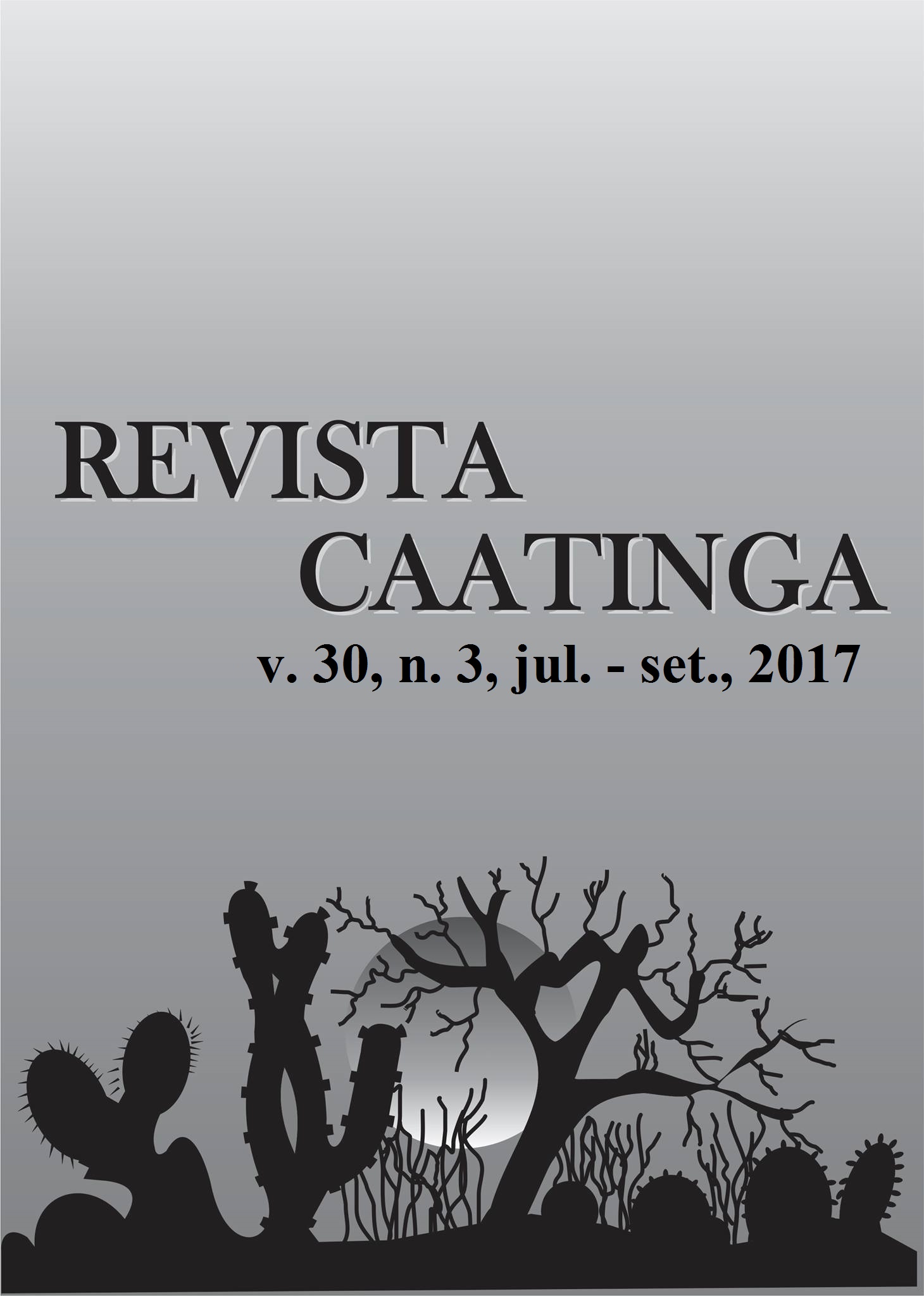LEGUMINOUS COVER CROPS FOR BANANA PLANTATIONS IN SEMI-ARID REGIONS
DOI:
https://doi.org/10.1590/1983-21252017v30n309rcKeywords:
Sustainable agriculture. Green manure. Caatinga. Pueraria phaseoloides. Calopogonium mucunoides. Musa spp..Abstract
High temperatures and low rainfall characterize the Brazilian semiarid regions. This regional climate demands the adoption of practices that increase the efficiency and sustainability of local farming. This study aimed to assess the ability of two perennial herbaceous leguminous species, calopo and tropical kudzu, to provide permanent soil cover in banana plantations in Jequitinhonha Valley, northeast Minas Gerais state, Brazil. To this end, we evaluated the differences of calopo and tropical kudzu in soil cover capacity and the amount of senescent phytomass deposited on the soil surface, nutrient content in senescent phytomass, as well as their effects on temperature and soil moisture, compared with bare soil in two experimental sites. The results showed that, compared with tropical kudzu, calopo had a higher soil cover capacity and was more effective at increasing organic material and nutrients in the soil owing to the relatively higher amount of senescent phytomass deposited on the soil surface. However, both calopo and tropical kudzu reduced soil temperature and increase soil moisture compared with bare soil. Overall, we concluded that these species can deposit high levels of senescence in the soil, providing several benefits to the cultivation system of banana plants in the semiarid regions.Downloads
References
BORGES, A. L., OLIVEIRA, A. M. G.; SOUZA, L. Solos, nutrição e adubação da bananeira. 1. ed. Cruz das Almas, BA: EMBRAPA CNPMF, 1995. 44 p.
BRASIL. MINISTÉRIO DA INTEGRAÇÃO NACIONAL. Câmara dos Deputados. Nova delimitação do semiárido brasileiro. Estudo, Brasília, DF, 2007. p. 24.
CHAUHAN, Y. et al. Using APSIM-soiltemp to simulate soil temperature in the podding zone of peanut. Australian Journal of Experimental Agriculture, Melbourne, v. 47, n. 8, p. 992-999, 2007.
COELHO, V. H. R. et al. Dinâmica do uso e ocupação do solo em uma bacia hidrográfica do semiárido brasileiro. Revista Brasileira de Engenharia Agrícola e Ambiental, Campina Grande, v. 18, n. 1, p. 64–72, 2014.
DABNEY, S. M.; DELGADO, J. A.; REEVES, D. W. Using winter cover crops to improve soil and water quality. Communications in Soil Science and Plant Analysis, Philadelphia, v. 32, n. 7-8, p. 1221–1250, 2001.
EMBRAPA. Métodos de análise de tecidos vegetais utilizados na Embrapa Solos. 21. ed. Rio de Janeiro, RJ: EMBRAPA Solos, 2000. 47 p.
ESPINDOLA, J. A. A. et al. Decomposição e liberação de nutrientes acumulados em leguminosas herbáceas perenes consorciadas com bananeira. Revista Brasileira de Ciência do Solo, Viçosa, v. 30, n. 2, p. 321–328, 2006.
FÁVERO, C. et al. Modificações na população de plantas espontâneas na presença de adubos verdes. Pesquisa Agropecuária Brasileira, Brasília, v. 36, n. 11, p. 1355–1362, 2001.
INSTITUTO NACIONAL DE METEOROLOGIA - INMET. Banco de Dados Meteorológicos para Ensino e Pesquisa. Disponível em: <http://www.inmet.gov.br/portal/index.php?r=bdmep/bdmep>. Acesso em: 18 fev. 2016.
KASPAR, T. C.; SINGER, J. W. "The Use of Cover Crops to Manage Soil". Publications from USDA - Agricultural Research Service/ UNL Faculty. Paper 1382. 2011.
KÄTTERER T. et al. Roots contribute more to refractory soil organic matter than above-ground crop residues, as revealed by a long-term field experiment. Agriculture Ecosystems & Environment, Amsterdam, v. 141, n. 1-2, p. 184–192, 2011.
LIMA, R. C. C.; CAVALCANTE, A. M. B.; PEREZ-MARIN, A. M. Desertificação e mudanças climáticas no semiárido brasileiro. 1. ed. Campina Grande, PB: INSA, 2011. 209 p.
LONGO, R. M., ESPINDOLA, C. R. C-orgânico, N-total e substâncias húmicas sob influência na introdução de pastagens (Brachiaria sp.) em áreas de cerrado e floresta amazônica. Revista Brasileira Ciência do Solo, Viçosa, v. 24, n. 4, p. 723-729, 2000.
MALAVOLTA, E. Manual de nutrição mineral de plantas. 1. ed. São Paulo, SP: Ceres, 2006. 638 p.
MIRVAT, E. et al. Water Conservation Practices in Agriculture to Cope with Water Scarcity. International Journal of Water Resources and Arid Environments, Riyadh, v. 4, n. 1, p. 20-29, 2015.
MOHAMMED, S. A. Contribution of Weed Control and Tillage Systems on Soil Moisture Content, Growth and Forage Quality of (Clitoria & Siratro) Mixture under- rainfed conditions at Zalingei - western Darfur state – Sudan. Journal of Science and Technology, Kumasi, v. 3, n. 1, p. 80-92, 2013.
PERIN, A. et al. Cobertura do solo e estoque de nutrientes de duas leguminosas perenes, considerando espaçamento e densidades de plantio. Revista Brasileira de Ciência do Solo, Viçosa, v. 28, n. 1, p. 207–213, 2004.
SILVA, D. M. N. et al. Temperature and humidity of soil covered with perennial herbaceous legumes in the semiarid region of minas gerais state, Brazil. Bioscience Journal, Uberlândia, v. 32, n. 1, p. 11-19, 2016.
SILVA, E. S.; TRINCA, L. A.; NERY, J. T. Áreas espacialmente homogêneas de níveis de precipitação nas regiões sudeste e sul do Brasil. Revista Energia na Agricultura, Botucatu, v. 24, n. 3, p. 34–59, 2009.
TEODORO, R. B. et al. Leguminosas herbáceas perenes para utilização como coberturas permanentes de solo na Caatinga Mineira. Revista Ciência Agronômica, Fortaleza, v. 42, n. 2, p. 292–300, 2011.
Downloads
Published
Issue
Section
License
Os Autores que publicam na Revista Caatinga concordam com os seguintes termos:
a) Os Autores mantêm os direitos autorais e concedem à revista o direito de primeira publicação, com o trabalho simultaneamente licenciado sob a Licença Creative Commons do tipo atribuição CC-BY, para todo o conteúdo do periódico, exceto onde estiver identificado, que permite o compartilhamento do trabalho com reconhecimento da autoria e publicação inicial nesta revista, sem fins comerciais.
b) Os Autores têm autorização para distribuição não-exclusiva da versão do trabalho publicada nesta revista (ex.: publicar em repositório institucional ou como capítulo de livro), com reconhecimento de autoria e publicação inicial nesta revista.
c) Os Autores têm permissão e são estimulados a publicar e distribuir seu trabalho online (ex.: em repositórios institucionais ou na sua página pessoal) a qualquer ponto antes ou durante o processo editorial, já que isso pode gerar alterações produtivas, bem como aumentar o impacto e a citação do trabalho publicado (Veja O Efeito do Acesso Livre).







